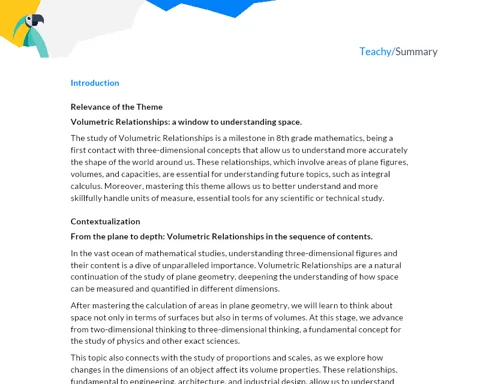Exploring Relationships and Equations of Quantities: Practice and Application
Objectives
1. Verify the type of relationship between two quantities and identify whether they are directly or inversely proportional.
2. Express the relationship between quantities through algebraic sentences.
3. Associate linear equations of the first degree with two unknowns to lines in the Cartesian plane.
Contextualization
The relationships between quantities are present in various daily activities and are essential in several professions. For example, in cooking, the amount of ingredients varies proportionally with the number of servings one wishes to prepare. In engineering, proportional relationships are used to design safe structures, such as bridges and buildings. Even in economics, data analysis often involves identifying relationships between variables to predict market trends. Understanding these relationships helps to solve practical problems efficiently and accurately.
Relevance of the Theme
Understanding relationships and equations of quantities is crucial not only for solving everyday problems but also for acting in various professional areas such as engineering, economics, and health sciences. This understanding allows the practical application of mathematical concepts, facilitating informed decision-making and the resolution of complex problems in the real world.
Directly Proportional Relationships
A directly proportional relationship between two quantities occurs when one increases or decreases in the same proportion as the other. For example, if we double the amount of an ingredient in a recipe, the number of servings produced also doubles.
-
If quantity A is directly proportional to quantity B, this can be expressed as A = kB, where k is a constant of proportionality.
-
Graphs of directly proportional relationships are straight lines that pass through the origin in the Cartesian plane.
-
Common examples include speed and distance traveled in a fixed time, or quantity of product and total cost.
Inversely Proportional Relationships
An inversely proportional relationship between two quantities exists when the increase of one results in the proportional decrease of the other. For example, if one faucet fills a tank in 3 hours, two identical faucets will fill the same tank in half the time, that is, 1.5 hours.
-
If quantity A is inversely proportional to quantity B, this can be expressed as A = k/B, where k is a constant of proportionality.
-
Graphs of inversely proportional relationships are hyperbolas in the Cartesian plane.
-
Examples include the relationship between speed and time to cover a fixed distance, or the number of workers and the time needed to complete a task.
Linear Equations of the First Degree with Two Unknowns
A linear equation of the first degree with two unknowns is an equation of the form ax + by = c, where a, b, and c are constants. The solution of this equation is a line in the Cartesian plane.
-
The standard form of a linear equation is ax + by = c.
-
To represent the equation graphically, one must find two points that satisfy the equation and draw the line that passes through those points.
-
Applications include determining costs and revenues in businesses, where x and y may represent different products or services.
Practical Applications
- Civil Engineering: Use of proportional relationships to calculate the amount of materials needed for constructing structures like bridges and buildings.
- Economics: Data analysis to predict market trends, identifying proportional and inversely proportional relationships between economic variables.
- Medicine: Calculation of medication dosages based on the proportional relationship between the amount of medication and the patient's weight.
Key Terms
-
Directly proportional relationships: Relationship between two quantities where one increases or decreases in the same proportion as the other.
-
Inversely proportional relationships: Relationship between two quantities where the increase of one results in the proportional decrease of the other.
-
Linear equations of the first degree: Equations of the form ax + by = c, where a, b, and c are constants, and their graphical representation is a line in the Cartesian plane.
-
Algebraic sentences: Mathematical expressions that represent the relationship between quantities using variables and constants.
-
Cartesian plane: Two-dimensional coordinate system used to graphically represent equations and relationships between quantities.
Questions
-
How do directly and inversely proportional relationships appear in your daily life? Give specific examples.
-
How can understanding linear equations help in your future professional career? Think of some specific professions.
-
How did the practical activity of building the bridge model help you better understand proportional relationships? What did you learn from this experience?
Conclusion
To Reflect
The relationships and equations of quantities are fundamental both in everyday life and in various professions. Understanding these relationships allows for solving practical problems efficiently and making informed decisions. The practical activity of building the bridge model demonstrated the application of proportionality concepts in a real context, highlighting the importance of these skills in the job market. Reflecting on how these relationships appear in our lives, we can perceive the relevance of mathematics in various areas, from engineering to economics and medicine.
Mini Challenge - Calculating Proportions in Daily Life
In this mini-challenge, you will apply the concept of proportional relationships to solve everyday problems.
- Choose a daily activity that involves proportions, such as cooking, calculating expenses, or planning a trip.
- Identify two quantities related proportionally in the chosen activity.
- Calculate the proportion between these quantities and write the algebraic sentence that represents this relationship.
- Describe how understanding this proportional relationship can help solve the problem more efficiently.
- Share your findings with your colleagues and compare different examples of proportions in daily life.



